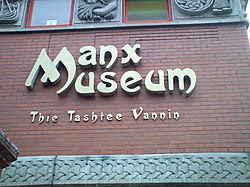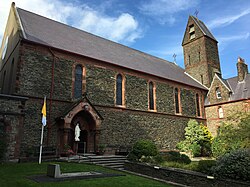Manx language
Manx, or Manx Gaelic (known in Manx as Gaelg or Gailck), is a language spoken on the Isle of Man.
| Manx | |
|---|---|
| Manx Gaelic y Ghaelg, y Ghailck | |
| Native to | Isle of Man |
| Native speakers | Extinct as a first language in 1974; subsequently revived and now with about a hundred competent speakers,[1][2] including a small number of children who are new native speakers,[3] and 1,823 people (2.27% de facto population) in the Isle of Man professing some knowledge of the language[4] (2011) |
| Language family | |
| Official status | |
| Official language in | |
| Regulated by | Coonseil ny Gaelgey (Manx Gaelic Council) |
| Language codes | |
| ISO 639-1 | gv |
| ISO 639-2 | glv |
| ISO 639-3 | glv |
| Linguasphere | 50-AAA-aj |
It is a Gaelic language, the same family as Scottish Gaelic and Irish. All of them are Celtic languages.
Manx is spoken mainly by people who learn it through interest. It died out as a natural community language in the 20th century. The last old native speaker died in 1974.
Manx is protected under the European Charter for Regional or Minority Languages.
History
Manx began to separate from Middle Irish in about 900–1600 AD and is called Yn Ghaelg Yn Ghailck by its speakers. There became fewer and fewer speakers during the 19th century, when the language was replaced by English. In the 1901 census, 9% of the people in the Isle of Man were said to speak Manx, but in the 1921 census, that had dropped to only 1%.
Today, Manx is used as the only language taught at five of the Isle of Man’s preschools. Manx is taught as a second language at all of the Isle of Man's primary and secondary schools.
Today
Today, Manx is used as the only language taught at five of the Isle of Man’s preschools. Manx is taught as a second language at all of the Isle of Man's primary and secondary schools.
There is now a school that teaches all of its lessons in Manx. According to the 2001 census, 2.2% of the population of the island could speak the language. There are currently 54,000 second-language speakers, mainly on the Isle of Man.
Manx Language Media
A Manx speaker, recorded in the Isle of Man
William Christian, better known as Illiam Dhone (Brown-haired William)
Lag ny Keeilley ("Hollow of the Church") on Cronk ny Arrey Laa ("Hill of the Day Watch"). The Manx language has had a substantial influence on the island's toponymy and nomenclature.
Use of Manx on the national museum, underneath the English
Loaghtan, a Manx breed of primitive sheep. The name means "mousy grey" in Manx.
References
| This language has its own Wikipedia project. See the Manx language edition. |






